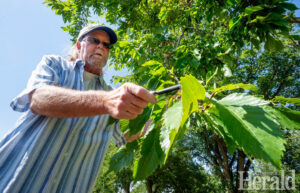Elm tree pruning ban in effect
By Tim Kalinowski on April 1, 2021.
 City urban forestry technician Lindsay Bell points out some of the features of an elm tree in a northside park in 2020 after forestry staff confirmed two trees were discovered to be infected with Dutch Elm Disease.
Herald file photo by Ian Martens
City urban forestry technician Lindsay Bell points out some of the features of an elm tree in a northside park in 2020 after forestry staff confirmed two trees were discovered to be infected with Dutch Elm Disease.
Herald file photo by Ian MartensLETHBRIDGE HERALDtkalinowski@lethbridgeherald.com
An elm tree pruning ban goes into effect today and will continue until Sept. 30 to try to prevent the spread of Dutch Elm Disease (DED) in the city.
Lethbridge became the first known jurisdiction to report positive cases of DED in the history of Alberta last year, making it more crucial than ever, says City of Lethbridge parks manager Dave Ellis, that residents respect the ban.
The City found two cases in different trees along public boulevards in 2020, but, as yet, no other instances on public or private property, confirms Ellis. He hopes to keep it that way.
“One thing we are doing different as a parks department is we are stepping up our monitoring,” Ellis states. “We have always monitored. We have had traps to monitor for beetle presence. But we will be stepping up the monitoring program and looking much more closely at both the public trees and the private trees we can see as well. We are happy to help with private property. If someone is not sure, call 311– and we will do our best to help out and get that inspection done.”
Dutch Elm Disease is a fungus which kills elm trees. The disease is spread from tree to tree by carrier beetles who like to feed on freshly pruned elms, particularly, and thus why the pruning ban is so important.
The City will be working in coordination with the Society to Prevent Dutch Elm Disease (STOPDED) in this effort to prevent further spread of this disease in neighbouring communities.
STOPDED executive director Janet Feddes-Calpas confirms her organization has received additional funding from the Canada Tree Fund to set up monitoring programs this summer in Brooks, Taber, Coaldale and possibly Diamond City.
“We have been carrying out a full prevention program throughout the province for a lot of years, and we have a prevention response plan, and we have a control response plan, in Lethbridge,” she states.
“What we want everyone in the province to be aware of is they need to be looking for the symptoms, and if they do find anything that looks suspicious with the wilting leaves is to phone it in. In Lethbridge at that 311 number, and we also have a provincial hotline for all the other communities.”
The provincial hotline number is 1-877-837-ELMS (3567).
A major symptom of the disease is a sudden bright yellowing of leaves in an otherwise healthy looking tree. If anyone sees this symptom in an elm tree they are encouraged to call in to have it inspected.
Feddes-Calpas said the likely vector for the disease’s arrival in Lethbridge was someone bringing in and storing elmwood from an area infected by DED outside of Alberta’s borders– probably neighbouring Saskatchewan which has had confirmed cases since 1981.
Lethbridge residents are now also prohibited from transporting any local elmwood outside of City boundaries due to these positive cases of DED.
Feddes-Calpas says there are about 600,000 elm trees in Alberta with an estimated value of $2 billion which are all at risk from Dutch Elm Disease.
-2


